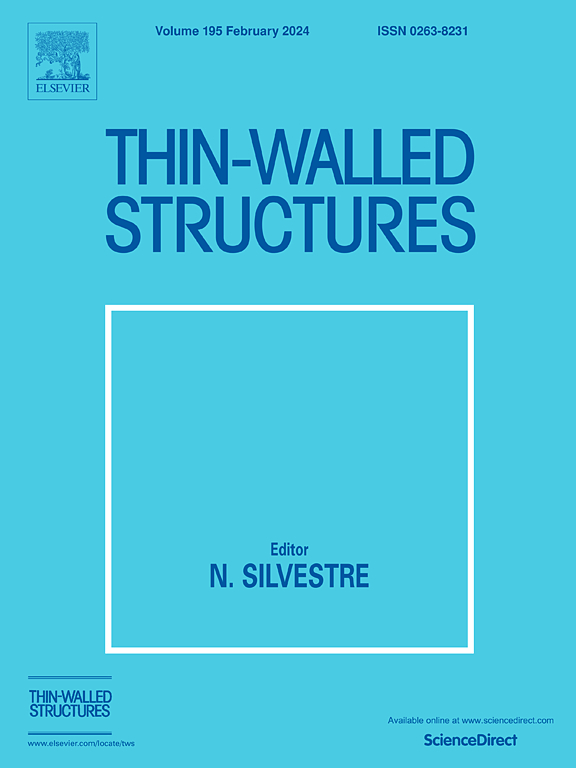In situ chemical bonding at the 30 wt.% GF/PA6-A2024 aluminium alloy interface via ultrasonic-assisted injection moulding
IF 5.7
1区 工程技术
Q1 ENGINEERING, CIVIL
引用次数: 0
Abstract
In injection moulding processes with metal inserts, chemical bonds cannot be directly formed at the interface between polymers and metals without the application of special intermediate agents to form chemical bridges, which involves cumbersome steps and reduces production efficiency. This work successfully achieved in situ chemical bonding on a 30 wt.% GF/PA6-A2024 joint during the injection moulding process with the assistance of ultrasonic vibration. Effects of ultrasonic time and ultrasonic power on the interfacial bonding strength at different temperatures were analysed. The mechanism of in situ chemical bonding generated by ultrasonic-assisted injection moulding was explored in depth through experimental characterization combined with molecular dynamics. An appropriate ultrasonic energy (the product of ultrasonic time and ultrasonic power) can reduce the viscosity of the melted polymer and increase the surface free energy of the metal, resulting in rapid interfacial bonding. Notably, ultrasonic vibration can also cause a sharp increase in the interfacial temperature, converting molten PA6 into an oxygen-rich state and realizing in situ C‒O‒Al and hydrogen bonds at the interface under cavitation impact. With an ultrasonic time of 10 s and an ultrasonic power of 400 W, the normal-temperature tensile shear strength of 30 wt.% GF/PA6-A2024 reached 40.98 MPa, which is a 97.9% improvement over that without ultrasonic vibration. This work can help eliminate the need to apply intermediate agents, enabling in situ chemical bonding at the interface during the injection moulding process and providing an environmentally friendly and efficient method for enhancing the interfacial bonding strength of metal‒polymer joints.
在使用金属嵌件的注塑成型工艺中,如果不使用特殊的中间剂形成化学桥,就无法在聚合物和金属之间的界面上直接形成化学键,这涉及到繁琐的步骤并降低了生产效率。这项研究利用超声波振动,在注塑成型过程中成功实现了 30 wt.% GF/PA6-A2024 接头的原位化学键合。分析了超声波时间和超声波功率对不同温度下界面结合强度的影响。通过实验表征结合分子动力学,深入探讨了超声波辅助注塑成型产生的原位化学键合机理。适当的超声波能量(超声波时间和超声波功率的乘积)可以降低熔化聚合物的粘度,增加金属的表面自由能,从而快速形成界面粘结。值得注意的是,超声波振动还能使界面温度急剧升高,使熔融 PA6 转变为富氧状态,并在空化冲击下实现界面上的原位 C-O-Al 键和氢键。在超声时间为 10 s、超声功率为 400 W 的条件下,30 wt.% GF/PA6-A2024 的常温拉伸剪切强度达到了 40.98 MPa,比没有超声振动时提高了 97.9%。这项工作有助于消除使用中间剂的需要,在注塑成型过程中实现界面原位化学键合,为提高金属聚合物接头的界面键合强度提供了一种环保、高效的方法。
本文章由计算机程序翻译,如有差异,请以英文原文为准。
求助全文
约1分钟内获得全文
求助全文
来源期刊

Thin-Walled Structures
工程技术-工程:土木
CiteScore
9.60
自引率
20.30%
发文量
801
审稿时长
66 days
期刊介绍:
Thin-walled structures comprises an important and growing proportion of engineering construction with areas of application becoming increasingly diverse, ranging from aircraft, bridges, ships and oil rigs to storage vessels, industrial buildings and warehouses.
Many factors, including cost and weight economy, new materials and processes and the growth of powerful methods of analysis have contributed to this growth, and led to the need for a journal which concentrates specifically on structures in which problems arise due to the thinness of the walls. This field includes cold– formed sections, plate and shell structures, reinforced plastics structures and aluminium structures, and is of importance in many branches of engineering.
The primary criterion for consideration of papers in Thin–Walled Structures is that they must be concerned with thin–walled structures or the basic problems inherent in thin–walled structures. Provided this criterion is satisfied no restriction is placed on the type of construction, material or field of application. Papers on theory, experiment, design, etc., are published and it is expected that many papers will contain aspects of all three.
 求助内容:
求助内容: 应助结果提醒方式:
应助结果提醒方式:


